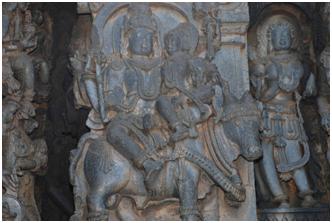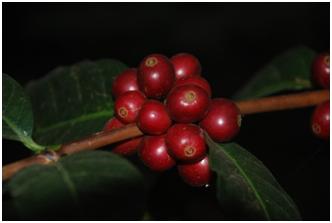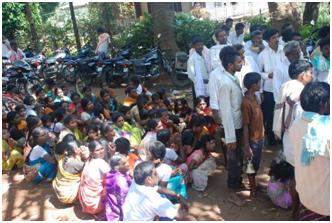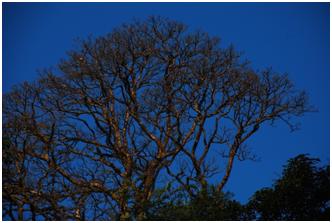12 Feb 2010
We started off on the drive to Chikmagalur bright and early in three cars. It took us more than an hour to get out of Bangalore and the drive was more peaceful after that. The first stop of the day was at Halebidu, which is about 170km from Bangalore. Halebidu means old city and in Halebidu the main attraction is the Hoysaleeswara temple, founded by the Hoysala kings. Halebidu was the capital of the Hoysala Empire in the 12th century.
Legend has that in the 12th century, one day a teacher and his disciples were taking a walk in the forest when they came up on a tiger. All the students but a boy named Sala ran away. The teacher called out to Sala to kill (Hoy) the tiger – “Hoy Sala”! The boy killed the tiger and later founded the Hoysala dynasty. They ruled most of Karnataka between the 10th and 14th century and their emblem showcases the incident of Sala killing the tiger. I was impressed to note that an ordinary boy went on to become the king and founded a dynasty that ruled for about 5-6 generations and decided to look more into this after I got back to Bangalore. Wikipedia says that the Hoysalas were rulers of the hills who took advantage of the then political situation to expand their empire. Looks like the legend may not have been really true!
Belur and Halebidu are twin cities and boast of two temples built by the Hoysala kings, which are of note. The Hoysaleeswara temple complex in Halebidu actually consists of two temples – Hoysaleeswara and Kedareeswara. These temples took 195 years of work to build. The two temples are built on a single platform and have very intricate carvings, which show a lot of dedication and skill from the workers. The construction is of sandstone and so it must have been easier to work on, but the detail is amazing.
Stories from Mahabharata, Ramayana etc. are carved into these stones and the temple itself is built on a star shaped platform to provide more surface area for the carvings. The sun was fairly strong but thankfully, there were carpets all round the temple. The interior of the temple was very cool, dark and nice. These temples are dedicated to Siva and there are two idols there. There was a frame that caught my eye at the second sanctorum wherein the idol itself was kept in a poorly lit position whereas the priest was standing upfront in a very visible position to give blessings. It struck me as akin to today’s situation wherein the priests are more important than the gods! A mischievous thought I guess, but I captured it in the camera nevertheless.
The guide we had was at pains to explain how the ancient Indian texts were the first to imagine such modern items as the submarine, missile etc. by pointing out some details from some carvings. It was fairly evident that the sculptors had a good sense of humour as well; or maybe it was the interpretation of the guide. There is one particular carving which shows Siva’s bull (Nandi) carrying both Siva and Parvati; supposedly Nandi is upset at carrying Parvati as he prides himself to be Siva’s vehicle and does not like carrying women around. Hence, he is shown in the sculpture with a slightly raised tail to denote his irritation. The guide was of the view that from ancient times man was above woman and hence this depiction. My view is that this must have been an impish sense of humour at work as ancient India definitely believed in man-woman equality as can be evidenced by the concept of the Ardhanaareeswara. In any case, the image is captured below.
I have always believed that the texts of Mahabharata and Ramayana have tried to portray the world as is and the stories are designed to show that everyone has goodness and badness in them and that even the gods are not above this. Indeed there is no single character in these texts, be it god or man that is without any blemish. One such incident is that of Rama, the personification of the Righteous Man, using devious means to kill Bali (the king of monkeys) so that his younger brother Sugreeva could become the king and help Rama. Rama is a great hero and an expert warrior; yet he shoots Bali with an arrow in the back, while the latter is engaged in a fist fight with Sugreeva. Clearly, this is not in line with the image of Rama as the epitome of goodness and valour but there has been enough cover provided through other stories (which came later, I feel) which talk about how Bali could be killed only from the back. I found it curious that the sculptors had deemed it fit to capture this image as well. See how Rama shoots an arrow through seven trees on to Bali’s back as he fights Sugreeva.
There are two large bulls also in the temple complex and according to the guide these are the sixth and seventh largest bulls in India. He went on to claim that the one dedicated to Parvati is the most beautiful one in India. I forgot to ask the guide as to why there is a bull dedicated to Parvati given Nandi’s clear displeasure in carrying her around!
The Halebidu temple complex leaves a lasting impression on one with the detail and the fine work on the sculptures. It is simply amazing and one cannot but be impressed with the skill of the artisans in those days. They did not have the sophisticated tools of today but were able to carve out these masterpieces. The pillars look as if they were carved on a lathe but of course, there were no lathes in those days. You are left with a sense of total awe and wonder at the skill and dedication of these artists.
We left Halebidu with a sense of wonder and a clear feeling that it would have been a tremendous loss had we decided to drop it from the agenda and proceeded straight to Chikmagalur. The Chikmagalur town was about an hour’s drive from Halebidu and we got directions from there to the estate we were staying in. We had booked rooms in a working coffee estate owned by Tata Coffee and we got there in time for lunch with the last leg of the drive being over characteristically bad roads. The rooms were all in one bungalow and we had the whole place to ourselves. Lunch was very nice, especially given the hunger. The rooms were pretty large and very nice.
Towards evening, I went for a walk in the estate by myself. Earlier in the day, Vinod had seen a large snake and he had also added that snakes were very common in coffee estates; this made me extra careful in my walk! The silence was the first thing that came to you as you got away from the buildings of the estate. There were no artificial sounds and to an extent, it was even unsettling. It occurred to me that the busy life in the city might have built this need in me to have signs of human life around me all the time. This was quite a disturbing thought indeed but nonetheless, I enjoyed my walk through the estate. I soon came upon a person named Nagaraja who was coming down the path. I conversed with him in my broken Kannada and learnt that the air gun he was carrying around was to shoot some bird (I thought it was peacock but I must have been wrong). The scenery was beautiful even if the light was not very conducive for photography. Ripe coffee beans were a beautiful sight and I could capture some interesting shots.
13 Feb 2010
Early mornings in such locations are always very beautiful and this one was no exception either but I felt a bit lazy and did not venture out. The sit-out in the bungalow faced east and I got an interesting shot as I was playing around with the camera.
I suggested that we visit Kemmangundi and if possible, go to Baba Budanagiri that day. This turned out to be not-so-good an idea as I had not thought about the bad roads and the long journey times. We hired a vehicle that could accommodate all of us and set off for Kemmangundi. The first stop was Kalahatti Falls and we reached there after a tiring drive. The fall itself turned out to be a very small affair with a bridge constructed across. Local people believe that the waters have medicinal properties and can cure illnesses. I was not feeling very well when we got there and did not go near the falls. In addition, there was some local festival going on when we got there and a good sized crowd had gathered.
The festival reminded me of our “Mariyamman Pooja” back home as there were people with decorated idols on their head. The overall ambience was very unsophisticated and hence looked quite innocent and sincere. There were some musical instruments which were very basic and there was no apparent expertise in how they were played and that added to the feel of the event.
The villagers looked very rustic and were not elegantly clothed. Yet, their devotion was very apparent and it was clear that they had simple beliefs. At one point in time, all the ladies squatted down in front of the people carrying the idols and they broke a coconut on the ground. The people with the idols then went around the women sprinkling the water on their heads. It all looked very solemn and there was not much gaiety around. In particular, I noticed one woman who seemed totally lost in her prayer – she continued squatting even after the procession was moving out; she seemed immersed in her own world.
We then proceeded to Kemmangundi, which was another 10 km or so away. The road was pretty bad but the scenery made up for it. Kemmangundi is a small hilltop but the views are fantastic. We also saw several people trekking. We stayed for sometime soaking in the views and then turned back home as most people were played out by then. With the prospect of the long ride back, no one felt like going to Baba Budanagiri – later, I heard that it might have been better to skip Kemmangundi and go there. Rest of the day was spent at the estate in a relaxed fashion although there was a hilarious game of “Lakori” played in-between wherein the boys’ team beat the girls’ team hands down.
14 Feb 2010
I got up early in the morning and went for a long walk and almost reached up to the end of the estate. Once again, the views were most exciting and I experimented with the exposure settings of my camera and got a beautiful shot.
We checked out of the estate after breakfast and proceeded to Belur. Belur was an about an hour’s time from the estate and our objective was to visit the Channakesava Temple, which is also built by the Hoysala kings. This is a smaller temple as compared to the one at Halebidu and took 95 years to complete. This is a temple which is under active use and has a nice courtyard. The temple was built by King Vishnuvardhana in the 12th century.
Interestingly, they first built a prototype of the temple and that took them about 20 years. After successful completion of the prototype, they launched the work on the real one. A picture of the prototype is given below.
As is the case with Halebidu, this temple is also built of soapstone and is littered with intricate carvings. Once again, the detail and quality of work is amazing. The statues are very life like and many stories are told in the sculptures with great eye to details, including facial expressions. Inside the temple, there is a statue of an ideal woman with mathematical proportions – unfortunately, I could not get a photo of that statue due to light and space constraints. Given below is the one of the most beautiful statues in the complex – a girl putting on ornaments. Parts of the statue are damaged but the quality of the work is pretty visible.
We left Belur with a feeling similar to what we had when we left from Halebidu – wonder and tremendous respect for the skills of those great artists that live in the years gone by and for the wonder that was India.



















